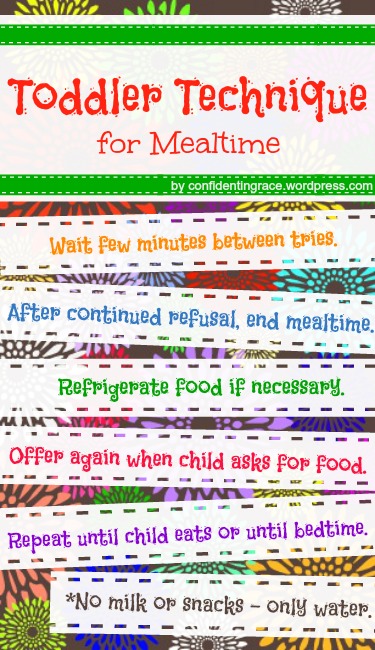What mom wouldn’t like her children to eat more of those healthy, vitamin-bearing vegetables? If only it was easy to get kids to like vegetables in the first place!
When our firstborn was a baby (13 years ago now), I thought I did everything I could to encourage veggie-loving in his diet. When he started baby food, I fed him vegetables first, not fruit. When he disliked a veggie, I would sneak it between bites of fruit or sometimes even mix the two. He ate many vegetables in mushy baby food form, but when it was time for finger foods, he balked. Alas, veggie-loving just does not come naturally to him, nor does it for many children.
With the birth of our second child, I determined to work even harder to create a love (okay, at least a tolerance) for veggies. And then the Lord, in His infinite wisdom, decided to bless us with a strong-willed, picky eater. 🙂 However, I learned much from dealing with his picky eating phase, a phase that felt like an eternity! By the time our twins came along, I had a much better idea of how to get those all-important vegetables in.
So, today on Mama Mondays, I offer you this list of 9 ways to sneak in those dreaded veggies!
**This post contains affiliate links. For more information on our affiliate use, please visit the About page.

-
Start from the very beginning.
I’m talking from within the womb! Researchers claim that babies begin to develop tastes for foods before they are even born. Taste buds develop around 21 weeks, at which point baby receives a flavoring of what mama eats via the amniotic fluid. So, if you want your child to grow up loving vegetables, start eating more of them yourself. Not only will this make for a healthier pregnancy, but you’ll also be more likely to feed your children foods that you already frequently consume when they get to the finger food stage. Too late for this tip? It’s never too late to start leading by example in the area of vegetable consumption! You can even practice sneaking in vegetables on yourself first. 🙂
-
Offer veggies first!
We’re all familiar with the fact that most children will eat the things they like most first and save the least favorite for last. Even adults do it. 🙂 If your children fill up on foods they like, getting them to eat those remaining vegetables will be even more difficult. On the other hand, if you offer the veggies first when they’re still hungry, they’ll be more likely to at least try a few bites.
-
Slice, dice, or even puree!
This might be obvious to some of you, but it wasn’t to me thirteen years ago. The smaller the veggies are, the less offensive they are to sensitive palates. My all-time favorite, couldn’t-live-without-it kitchen tool is my food chopper. If I place a nice helping of normal sized broccoli in front of my youngest son, he’ll immediately turn up his nose. However, if I chop that broccoli to bits, he’s more willing to eat it – especially if it is combined with another food or a sauce. This is my absolute favorite method for sneaking in vegetables! I know some moms who add pureed butternut squash and other veggies to the famous toddler favorite, Mac’n’cheese. The possibilities are endless when you dice and then ….disguise.
-
Disguise those veggies.
I looooove casseroles/slow-cooker meals for many reasons: only one dirty pan, time to do other chores while food is baking, etc. But my biggest reason for serving up lots and lots of casseroles is because it allows me to sneak in a lot of vegetables that my children wouldn’t eat alone. I add petite diced tomatoes, finely diced onions and mushrooms, and sometimes even bell peppers to spaghetti sauce and chili. I add California blend (diced, of course) to our chicken divan. If we have scalloped potatoes, you bet I’ll be hiding some veggies in there. Shepherd’s pie, homemade potpie, even fried rice – all of these dishes are veggie-friendly! You can even hide veggies within other veggies. How, you ask? If I gave my 7-year-old purple cabbage to eat, I’m sure he would run the other way. But he eats it in a salad, along with pieces of fresh radish and spinach. Twice baked potatoes, anyone? Stuffed bell peppers? Use whatever method works for sneaking in vegetables that your kids will learn to love!
-
Substitute veggies for other starches.
In addition to hiding veggies, I’ve recently learned how to substitute vegetables for pasta and potatoes. The spaghetti I mentioned above? Instead of pasta, use strings of baked spaghetti squash. The shepherd’s pie? Instead of potatoes, used mashed cauliflower. For chili broth, I use low-sodium V8 juice (and then I add even more veggies).
-
Add cheese, sauce, or dip.
Although this method can easily turn healthy veggies into big calorie veggies, when used in moderation, it’s an effective technique. We have a son who loooves condiments of all kinds, so I’ve learned to offer a small amount with his fresh vegetables. Low-fat cheese works well with cooked vegetables. We do whatever it takes to sneak in those vitamin-packed vegetables!
-
Offer a variety.
As I mentioned in How to Make Food Fun, research supports that offering a variety can lead children to eat more of a single food group than they realize, especially if the variety is colorful. For example, if you offer bell peppers, offer multiple colors of bell peppers. If you’re offering broccoli, why not offer California blend instead. A variety of vegetables gives children choices, as well, and we all know they love the power of choice! 🙂

-
Try, try, and try again…and then some more.
As a rookie mom, I had no idea how many times young children need to try a food before deciding whether they like it or not. But when our picky eater came along, I learned that children may need to try a food 10-15 times before making up their minds about it. It makes sense really! One day Johnny loves peas, and the next day he’ll have nothing to do with them. Often, we give up too soon on new foods and assume that they just don’t like them. Even if your child has repeatedly demonstrated dislike for a particular vegetable, tastes can change over time. It never hurts to pull a rejected veggie out after a few months and try it again!
-
Find the Why behind the “No.”
Sometimes there is a reason behind a child’s refusal of a food other than a dislike for the taste. I saw this clearly when our twins began to eat finger foods. Our daughter began to refuse banana, a fruit she previously loved mashed up. At first, I was baffled. One day I saw her try to pick up a piece of banana and she made the most disgusted face ever. It wasn’t the taste of the banana, but the sticky texture she was objecting to. I happily fed them to her from a spoon until she learned to use a spoon herself. Consider physical reasons for refusal as well, whether it be a texture issue (I still cannot eat beans unless they are pureed) or a possible food allergy. Once you understand any sensory issues, you will have no trouble sneaking in vegetables that your child won’t react to!
There you have it: Nine ways to sneak in more veggies. One last helpful hint – you can even use these tips on husbands – true story! 🙂
If you have a clever way to sneak in veggies, pretty please share with us in the comments.
Jen 🙂
If you found this article helpful, you might also enjoy:





